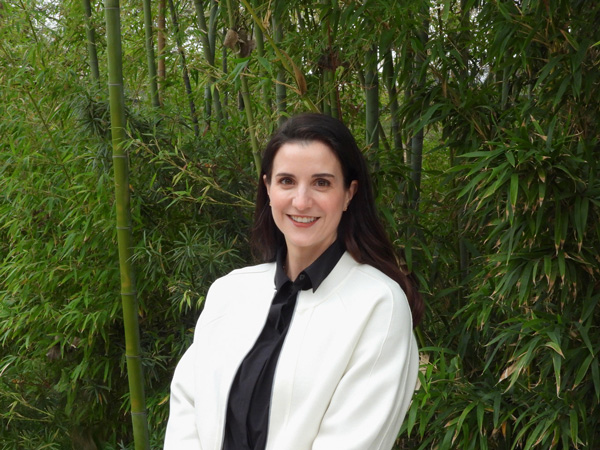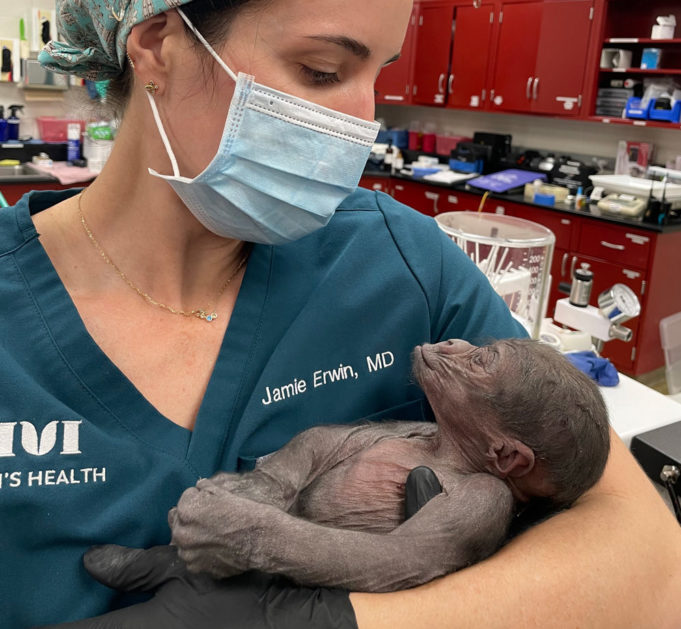A profound calmness and determination filled the quiet operating room as an accomplished medical team stood united for a common surgery in a setting that was clearly uncommon. Veterinarians and human medical doctors were about to begin a historic mission to save the lives of two western lowland gorillas, a critically endangered species.
Lying on the operating table before Dr. Jamie Walker Erwin was the unlikeliest of patients: Sekani, a 33-year-old female gorilla from the Fort Worth Zoo. Prior to the unusual scene, a sudden and life-threatening pregnancy complication left Sekani and her unborn baby in peril. After a series of rapid developments, the zoo decided to call in a team of medical experts. Erwin, a Fort Worth obstetrician and gynecologist who has worked with the zoo since 2015, said she felt a “range of emotions” before surgery.
“Just seeing this animal, and she’s so huge and beautiful — that was very different than the typical setup, of course,” Erwin said.
As Sekani was prepped, the novelty faded, and the medical team began their work, each of them playing their role with precision.
“I don’t think any of us were thinking how historic this was,” Erwin said. “It was all just very automatic.”
Just days earlier, Erwin and the zoo’s veterinary team were planning a routine sonogram for Sekani in mid-January. Her pregnancy appeared to be normal.
Then the gorilla suddenly began showing signs of distress: She was holding her head as if she had a headache; she had a lip quiver, a common indicator of pain; and a urine test all pointed to preeclampsia, a serious pregnancy complication found in both primates and people.
Erwin was 700 miles away on a vacation in Colorado Springs with her husband, 13-year-old daughter, and 8-year-old son when she began receiving calls from the zoo’s veterinarian team about Sekani’s condition.
When the decision was made to deliver Sekani’s baby via cesarean surgery, Erwin rushed back to Fort Worth on a flight filled with anticipation, she said.
“It was all just very exciting,” Erwin said.
The doctor recalled turning to her husband and saying, “I’m going to go to this. We’re going to do this. I’m going to go help deliver a gorilla. I was just trying to process that. I think I’m still trying to process that.”
On Jan. 5, 2024, the gorilla’s birth became the third in the Fort Worth Zoo’s 115-year history and the first c-section birth, the zoo said.
The baby gorilla was named Jameela, a play on Erwin’s first name, Jamie. In Swahili, Jameela means “beautiful.”
Following the surgery, the zoo said Jameela had fluid cleared from her lungs and received respiratory support for several hours.

Photo by Teri Webster
At the close of the surgery, some zoo staff members were waiting in an adjacent room. They were increasingly concerned about whether Jameela would survive the ordeal, said Linda Roberts, the zoo’s primate supervisor. As they caught glimpses of the medical team working on the 3-pound infant, they braced for the worst.
“I was really nervous, but I tell you, what really helped me is that they were all so calm,” Roberts said. “They were just like, ‘This is what we do,’ and I felt like she was in good hands. We were OK.”
Roberts said she could see the doctors “talking to each other, and their whole effect was really peaceful and calm.”
Although Sekani appeared listless after the surgery, that was primarily due to the anesthesia still in her body, Erwin said.
Still, the moment was tense for Roberts, a 33-year veteran of the Fort Worth Zoo who also served as a lead gorilla keeper for the Bronx Zoo.
Relief set in as both Sekani and Jameela successfully recovered, Roberts said. “Jameela is great. She’s getting top grades in all of her physicals.”
Now another challenging “operation” is underway, one that concerns Jameela’s around-the-clock care and finding an appropriate surrogate mother.
Initially, Sekani showed little interest in her baby, possibly because the necessary hormones weren’t released due to the premature birth, the zoo said. As of this writing, Jameela’s future plans remain in flux.
“The zoo is committed to ensuring Jameela receives the best care possible, which means ultimately being raised by gorillas,” said Avery Elander, the zoo’s director of marketing and public relations. “Here at the Fort Worth Zoo, we are committed to finding her the best possible surrogate, and training is a day-by-day endeavor that continues to evolve.”
If no female from the gorilla troop takes on the role of Jameela’s mom, it’s possible that she could be sent to another zoo, Roberts said. Baby gorillas must learn to interact with and “read” other gorillas to successfully integrate into a troop.
“I wished Sekani had bonded with Jameela, of course,” Erwin said. “That would have been such an amazing, happy ending to this story, but, sadly, that doesn’t seem to be the case. It is still possible, and I know the keepers are still training with Sekani. Ultimately, the most important thing is Sekani and Jameela are both alive and well and [that] Jameela will be raised by gorillas. Families don’t always look the same for everyone, even gorillas. Sometimes we lean on our extended family members and even friends to help raise our kids. I know I do. And I think that is just as beautiful.”
One of the zoo’s gorillas, Gracie, is under consideration as a surrogate mother for Jameela. The 24-year-old gorilla has two offspring and already knows how to present or raise a baby up to the protective mesh barrier that separates the gorillas from the keepers. That allows the keepers to visually examine the baby and provide supplemental feedings or other care, if needed.
As she is watched and cared for by the keepers, Jameela rests in a specially designed hanging bassinet. Her bed is attached to the opposite side of a mesh barrier so the other gorillas can get close to her.
Jameela is also learning to hang onto a jacket designed to mimic gorilla hair and has a shag rug that allows her to crawl and practice grabbing. That’s an important behavior because baby gorillas hang on to their mothers constantly, Roberts said.
Elmo, the zoo’s muscular 420-pound silverback western lowland gorilla, has shown tenderness toward Jameela, as he has with other youngsters, Roberts said. During an initial meeting, Elmo walked up to the bassinet, sniffed Jameela, and gave a happy grunt.
Behind the scenes, keepers have worked with Jameela in eight-hour shifts that run 24/7, Roberts said. An air mattress in a makeshift nursery allows the keepers working overnight to get some sleep.
The circumstances, extensive care, and the partnership between human and animal doctors caused a whirlwind of local and national media attention. Delivering Jameela led to recognition Erwin never anticipated, and she called the experience a “highlight of her career.”
She is also learning more about the gorillas’ care as well as the challenges they face in the wild, Erwin said.
Habitat destruction, illegal bushmeat and wildlife trades, and disease are among the threats gorillas face, based on extensive data by the World Wildlife Fund (WWF). An estimated 250,000 to 300,000 gorillas are believed to remain in the wild, the WWF said. The critically endangered species is one that plays a vital role in the balance of Africa’s rainforest ecosystem.
As for Jameela, Erwin said she plans on making plenty of follow-up visits. “As much as they will let me. I’m afraid of annoying them. I want to text them all of the time and ask, ‘How is she doing?’ and if I can come see her. They’ll probably get tired of me,” she said with a laugh.
But in an inexplicable way that animals sometimes do, Jameela has left her small footprints on Erwin’s heart.
“I’m a Jameela fan all the way,” the doctor said.
Read about the latest news in reproductive rights in Metro/Static.












